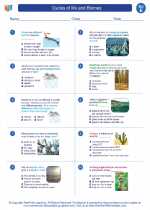Horsetails: A Study Guide
What are Horsetails?
Horsetails, also known as Equisetum, are a group of perennial, herbaceous plants that are often found in wet environments such as marshes, swamps, and along rivers and streams. They are characterized by their hollow, jointed stems and feathery, whorled branches.
Life Cycle of Horsetails
Horsetails reproduce through spores. The spores develop in spore-producing structures called sporangia, which are typically found in cone-like structures at the tips of the branches. When the spores are mature, they are released and dispersed by the wind. If conditions are favorable, the spores germinate and develop into a new plant.
Unique Features of Horsetails
Horsetails are known for their high silica content, which gives them a rough texture and makes them useful for polishing and scouring. They are also one of the oldest groups of plants, with a fossil record dating back to the Devonian period, over 350 million years ago.
Ecological Importance
Horsetails play an important role in their ecosystems. They can help stabilize soil in wetlands and provide habitat for various organisms. Some species of horsetails are also used in traditional medicine and as a source of food for certain animals.
Uses of Horsetails
Historically, horsetails have been used for a variety of purposes, including as a source of rough material for polishing, as a traditional herbal remedy, and even as a food source. In modern times, they are also used in horticulture and as ornamental plants in gardens and landscaping.
Conclusion
Horsetails are fascinating plants with a long history and ecological importance. Studying them can provide insights into plant evolution, ecology, and human uses of plants.
.◂Science Worksheets and Study Guides Fifth Grade. Cycles of life and Biomes

 Worksheet/Answer key
Worksheet/Answer key
 Worksheet/Answer key
Worksheet/Answer key
 Worksheet/Answer key
Worksheet/Answer key
 Worksheet/Answer key
Worksheet/Answer key
 Vocabulary/Answer key
Vocabulary/Answer key
 Vocabulary/Answer key
Vocabulary/Answer key
